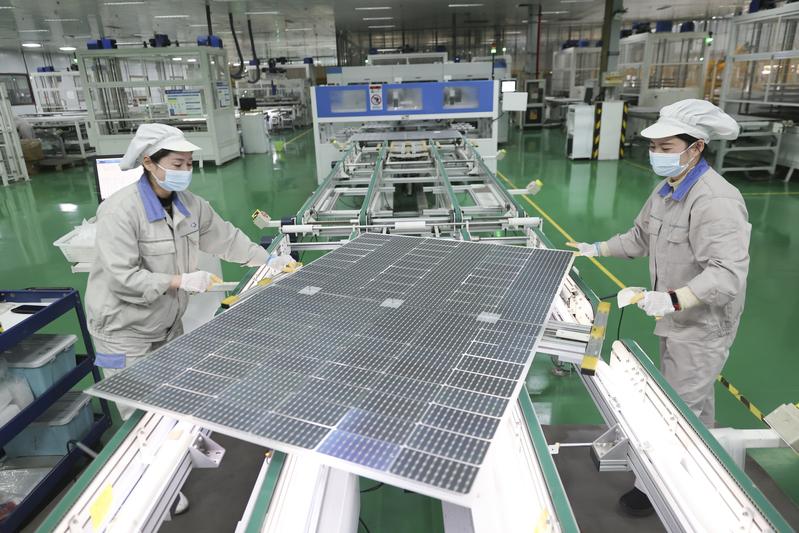 Employees work at a solar panel unit of a company in Lianyungang, Jiangsu province. (SI WEI / FOR CHINA DAILY)
Employees work at a solar panel unit of a company in Lianyungang, Jiangsu province. (SI WEI / FOR CHINA DAILY)
Reduced energy consumption and rapid development of renewables helped accelerate China's transition to a green and low-carbon economy last year, the National Bureau of Statistics said in a report on Tuesday.
Energy consumption per 10,000 yuan ($1,441) of GDP decreased by 0.1 percent in 2022 compared to 2021. Power generated from clean energies, including hydropower, nuclear power, wind power and solar power, reached 2.96 trillion kilowatt-hours in 2022, up 8.5 percent year-on-year, the NBS said.
Sheng Laiyun, deputy head of the NBS, said in a written comment published on the bureau's official website, that China has actively and steadily promoted the work of peaking carbon emissions and achieving carbon neutrality last year, besides accelerating the green transformation of industries' development. The country also continuously improved its ecology and environment. Efforts were also made to reduce energy consumption and control emissions.
Data from the National Energy Administration showed that in 2022, China's wind and photovoltaic power generation exceeded 1 trillion kWh for the first time, reaching 1.19 trillion kWh, an increase of 207.3 billion kWh compared to 2021 or a yearly increase of 21 percent.
At a recent news conference, Wang Dapeng, deputy head of the new energy and renewable energy bureau of the NEA, said that as the proportion of new energy in the overall energy mix continues to increase, it is necessary to pay more attention to the consumption of electricity generated from renewables, in order to promote the high-quality development of new energies.
Wang also said China is pushing to amend relevant laws and regulations, further improve the green electricity certificate system to support renewable energy development, and establish a mechanism to guarantee consumption of power generated from new energies based on the green certificate system to reduce wastage of electricity.
Green power certificates are the "electronic ID cards" for the green electricity generated by renewable energy companies. They are used to calculate and verify new energy power generation and use. Each green power certificate represents an amount of 1,000 kWh of electricity generated from renewables that has been connected to the grid and consumed.
Use of renewable energy in the industrial, transportation and construction sectors will be promoted. The layout of pumped storage hydroelectricity facilities will be optimized, Wang said.
Jing Chunmei, director of scientific research and information at the China Center for International Economic Exchanges, said that accelerating the development of a network that integrates wind, solar and coal-fired power with power storage and hydrogen power is of vital importance to support new energy development and coordinate economic development with low-carbon transformation.
"To establish the network, more efforts are needed to cope with any potential problems arising from transmission and consumption of power generated from new energies. This can be done through measures such as smart grids, virtual power plants and power storage systems," she said.
"Differing from fossil fuels, power generated from new energies has higher requirements for the safe and stable operation of power systems. That is because most new energies are intermittent resources, which undergo sudden or random fluctuations. This makes it difficult to realize stable and steady power generation. In addition, it presents challenges to grid stability, such as voltage fluctuations, during power transmission," said Lin Boqiang, head of the China Institute for Studies in Energy Policy at Xiamen University in Fujian province.


